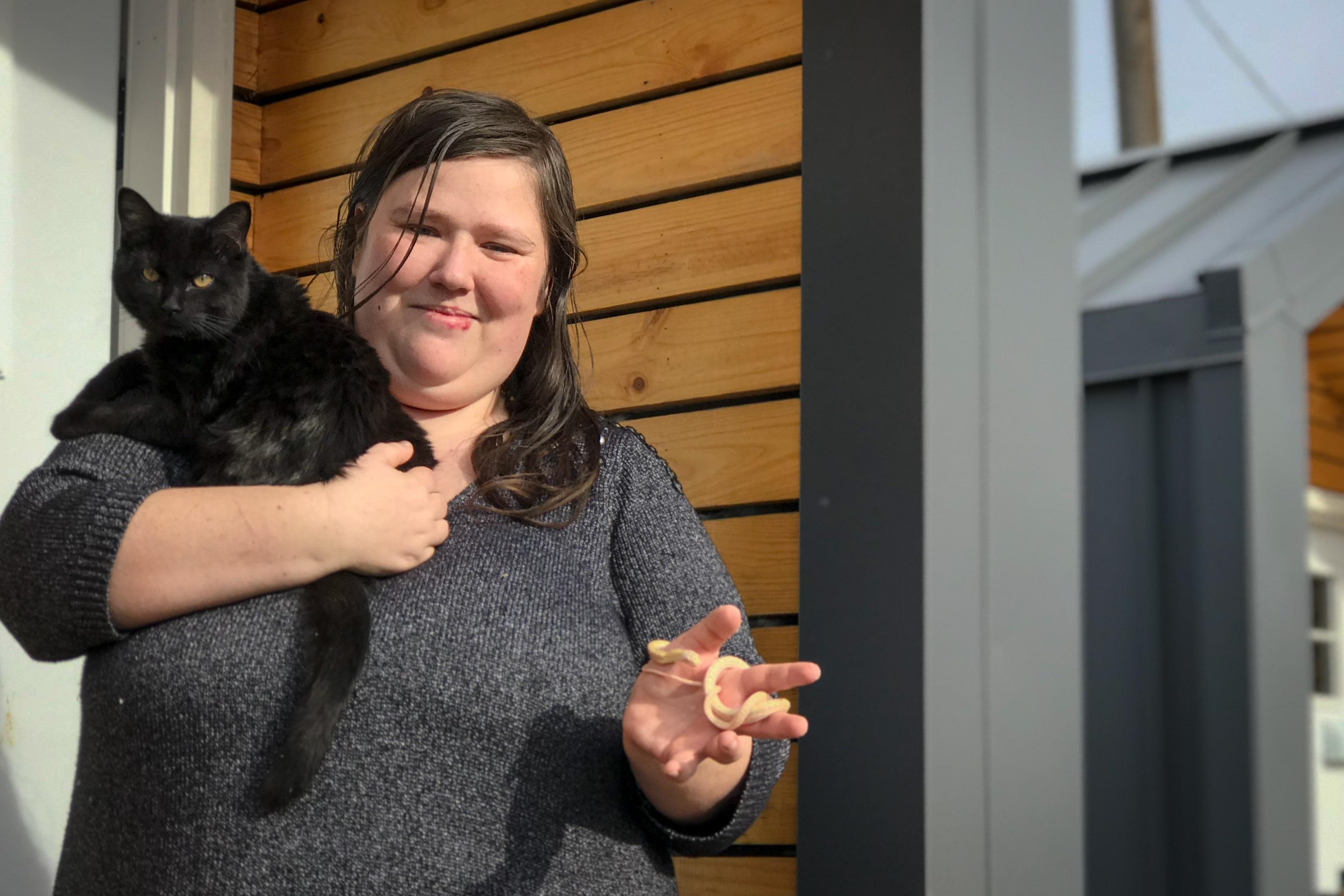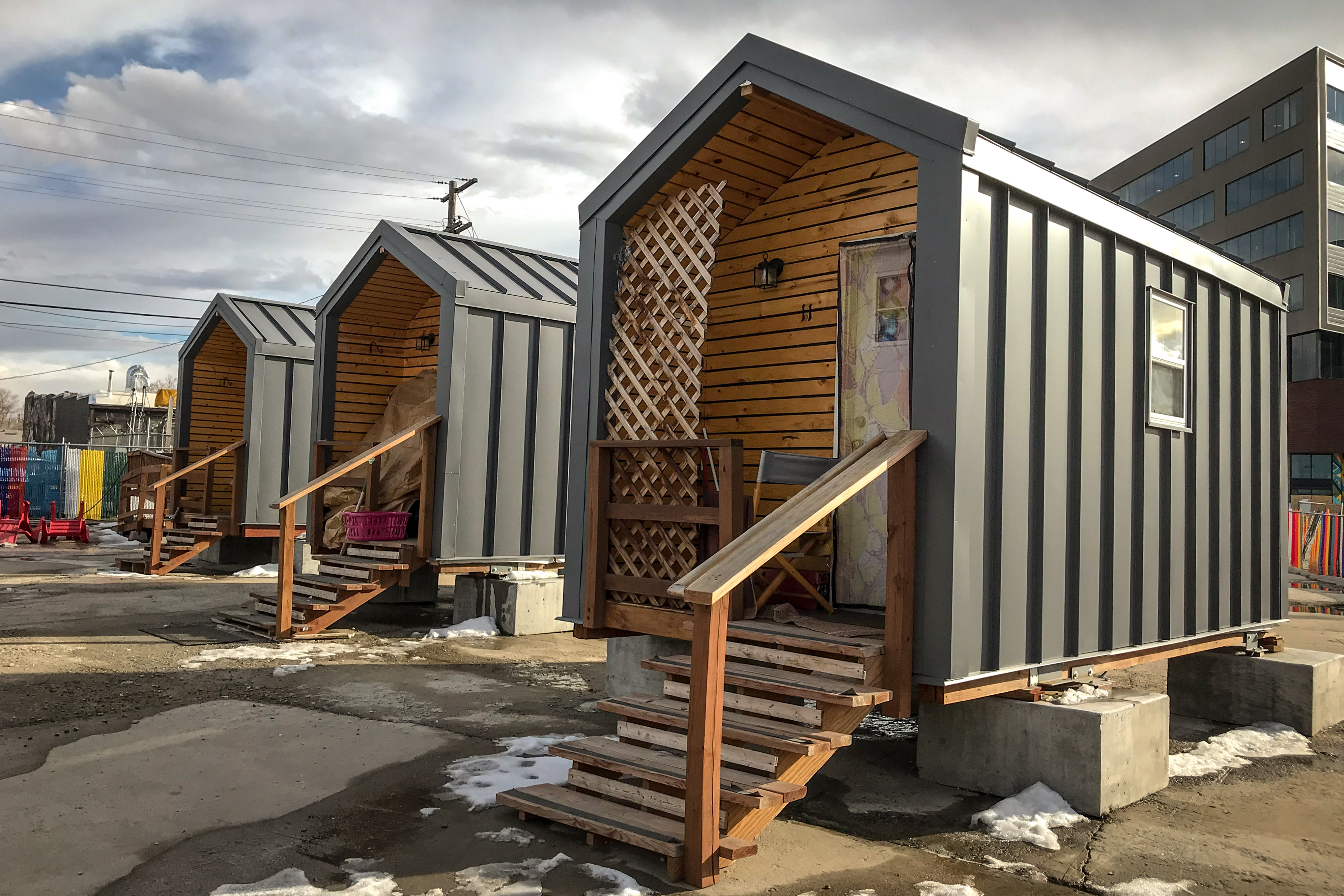

Denver’s community of 11 tiny houses is meant to give people experiencing homelessness a place to land until they can find something permanent. The Beloved Community Village started as a pilot two years ago, and now has the strong backing of Denver officials.
As the tiny home idea gains steam in Denver and elsewhere — like Seattle — some homeless advocates say they aren’t the right idea.
Each house is a single, 80-square-foot room with heat and lights. No plumbing. Residents share a communal kitchen, bath house and porta-potties.
Before the village, Sandra Hermans would shelter hop and sleep along the Platte River. Her stuff would get stolen and she said she carried a knife for protection. Shelter curfew meant she was left on the street if she got there late after work.
Hermans has lived here for more than a year now and the tiny house has been great.
“It’s a huge relief,” she said. “I like being able to go somewhere at the end of the day and just flop down and not worry about being bothered or being cold or being hungry.”
She even has pets — a kitten, snakes and a couple of rats.
The people behind the Beloved Community got started on the concept six years ago, under the activist group of Denver Homeless Out Loud. The idea is to be nimble and cheap. Instead of buying land, they’d take advantage of empty lots around the city.
The unsheltered homeless population in the Denver metro has grown nearly 60 percent over the last five years, to around 1,300 individuals. With that number in mind, Colorado Village Collaborative co-director Tanya Salih said the tiny homes are needed.
This first community served 11 people, give or take roommates. The vision is to eventually have tiny home villages around Denver. The next step would be to move people into permanent housing, which five people have so far.
Residents aren’t charged for the tiny home, “in hopes of them saving everything that they’re earning, to the point where they can make a deposit and then pay for their first month rent,” she said. “But Denver’s a really hard market for that. So, you know, these things do take time.”

The city partnered with the tiny home activists in 2016, and has since helped cover relocation costs when the community has had to move. Which they will have to do again. The land they’re on in Five Points is slated to be developed, so the city offered a piece of land in Globeville, in northeast Denver, for a $10 a year lease.
Residents in Globeville balked, so the plan is on hold.
It’s an indication that moving these villages around the city won’t be an easy sell. This will be the second move for the village in less than two years. Each relocation costs thousands of dollars and steals resources from plans to build other villages.
It’s these kinds of challenges that has caused some advocates to come out against the tiny village concept.
“You’re looking for permanent housing solutions to homelessness, and this is neither permanent or real housing,” said Sam Tsemberis, the CEO of Pathways Housing First.
In the 90s, Tsemberis’ radical idea to get people off the streets was to give them a place to live with no requirements of sobriety. Meet their basic needs first, like food, water and shelter, and then residents can work toward a job and treatment. The concept is known as Housing First, and it’s shown to work.
“Why don’t we just skip the tiny houses all together and put them in permanent housing right away,” Tsemberis asked. “And then we already have the success were yearning for instead of having people wait a year to get there!”
Tsemberis’ work has changed the way many cities address homelessness, Denver included. The Colorado Coalition for the Homeless launched a Housing First program over 20 years ago. And in 2016, the city and a group of private investors created a Social Impact Bond, a program that posits the housing first model can actually save a city money.
Denver estimates a single chronically homeless person costs taxpayers $29,000 a year.
In the bond arrangement, investors pay the upfront costs of housing the city’s most frequent users of the criminal justice system. Then the city repays the investors based on their own results, which have been strong — a retention rate of over 85 percent.
John Parvensky, who’s been president and CEO of the Colorado Coalition for the Homeless for more than 30 years, said temporary housing in any form, tiny homes included, can be an unnecessary and costly step.
“Most people can move directly from the streets or the shelters into permanent housing if given the right supports and the right resources,” Parvensky said.

He appreciates the enthusiasm of the tiny home advocates, but he argues it’s not practical. In the four years it’s taken to get 11 tiny homes established, the coalition has opened around 200 units of housing.
“And that is not enough in this market and the needs that we have out on the streets,” he said.
There’s a growing overflow of people who stay in shelters or on the street every night. Parvensky realizes shelters aren’t perfect, but they serve those who need them at a scale he believes tiny homes can’t match.
“It takes too much concentration and dedication of land resources, which are very difficult to find these days,” Parvensky said.
Neither the National Alliance to End Homelessness or the U.S. Interagency Council on Homelessness fully endorse the tiny house concept, but communities want solutions as unsheltered homeless populations rise.
Seattle has gone all in with a network of nine villages with more than 300 units. The city embraced the idea after it declared a state of emergency for homelessness in 2015. Seattle Times reporter Vianna Davila, pointed out that the city’s villages are also temporary, and some are near the end of their leases.
“What is the exit plan for these people and what is the exit plan for the village?” Davila said. “If you’re saying the village is impermanent, well, what does that look like then?”
Seattle’s plan isn’t clear, but the goal is to get residents into permanent housing. One village is scheduled to close, partly because residents weren’t placed into housing at the rate the city wanted.
Davilla said Seattle’s villages face similar issues to Denver’s: opposition from neighbors, difficulties finding available and affordable land, and the question of exactly how to help people find permanent housing.
“The city agrees that case management is really critical if you’re going to move people from these villages to some kind of housing situation,” she said. “That can get expensive.”
That’s where Evan Dryer, deputy chief of staff to Denver Mayor Hancock, would like to see more city involvement. Resources like case managers could help the village move residents into a more permanent situation. In turn, more could then move into the village and the cycle repeats.
Despite the disapproval from some key experts, Dryer said the tiny house concept is worth trying out.
“If we’re looking at a strategy that involves multiple answers and multiple solutions, a tiny home village is an important part of that equation,” he said.
A vote by the Denver City Council on whether to let the village settle in Globeville has been postponed. The Beloved Community has until mid-May to find a new location, and in that time they hope to win over the neighborhood. The Colorado Village Collaborative will also search for backup options, in hopes of keeping the experiment going.
Editor's Note: An earlier version of this story referenced the growth rate of the unsheltered homeless population in the city of Denver. The number cited was the number for larger metro area. The story has been corrected properly cite the metro area.









